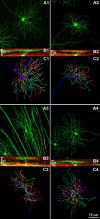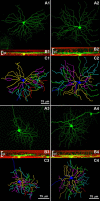Retinal ganglion cells survive and maintain normal dendritic morphology in a mouse model of inherited photoreceptor degeneration
- PMID: 19109509
- PMCID: PMC2633359
- DOI: 10.1523/JNEUROSCI.4968-08.2008
Retinal ganglion cells survive and maintain normal dendritic morphology in a mouse model of inherited photoreceptor degeneration
Abstract
Retinitis pigmentosa (RP), a family of inherited disorders characterized by progressive photoreceptor death, is a leading cause of blindness with no available cure. Despite the genetic heterogeneity underlying the disease, recent data on animal models show that the degeneration of photoreceptors triggers stereotyped remodeling among their postsynaptic partners. In particular, bipolar and horizontal cells might undergo dendritic atrophy and secondary death. The aim of this study was to investigate whether or not concomitant changes also occur in retinal ganglion cells (RGCs), the only retinal projection neurons to the brain and the proposed substrate for various therapeutic approaches for RP. We assessed the retention of morphology, overall architecture, and survival of RGCs in a mouse model of RP at various stages of the disease. To study the morphology of single RGCs, we generated a new mouse line by crossing Thy1-GFP-M mice (Feng et al., 2000), which express GFP (green fluorescent protein) in a small number of heterogeneous RGCs types, and rd10 mutants, a model of autosomal recessive RP, which exhibit a typical rod-cone degeneration (Chang et al., 2002). We show remarkable preservation of RGC structure, survival, and projections to higher visual centers in the time span from 3 to 9 months of life, well beyond the death of photoreceptors. Thus, unlike second-order neurons, RGCs appear as a considerably stable population of cells, potentially constituting a favorable substrate for restoring vision in RP individuals by means of electronic prostheses or direct expression of photosensitive proteins.
Figures






References
-
- Alpár A, Palm K, Schierwagen A, Arendt T, Gärtner U. Expression of constitutively active p21H-rasval12 in postmitotic pyramidal neurons results in increased dendritic size and complexity. J Comp Neurol. 2003;467:119–133. - PubMed
-
- Badea TC, Nathans J. Quantitative analysis of neuronal morphologies in the mouse retina visualized by using a genetically directed reporter. J Comp Neurol. 2004;480:331–351. - PubMed
-
- Barhoum R, Martínez-Navarrete G, Corrochano S, Germain F, Fernandez-Sanchez L, de la Rosa EJ, de la Villa P, Cuenca N. Functional and structural modifications during retinal degeneration in the rd10 mouse. Neuroscience. 2008;155:698–713. - PubMed
-
- Carcieri SM, Jacobs AL, Nirenberg S. Classification of retinal ganglion cells: a statistical approach. J Neurophysiol. 2003;90:1704–1713. - PubMed
Publication types
MeSH terms
Substances
Grants and funding
LinkOut - more resources
Full Text Sources
Other Literature Sources
Molecular Biology Databases
Miscellaneous
